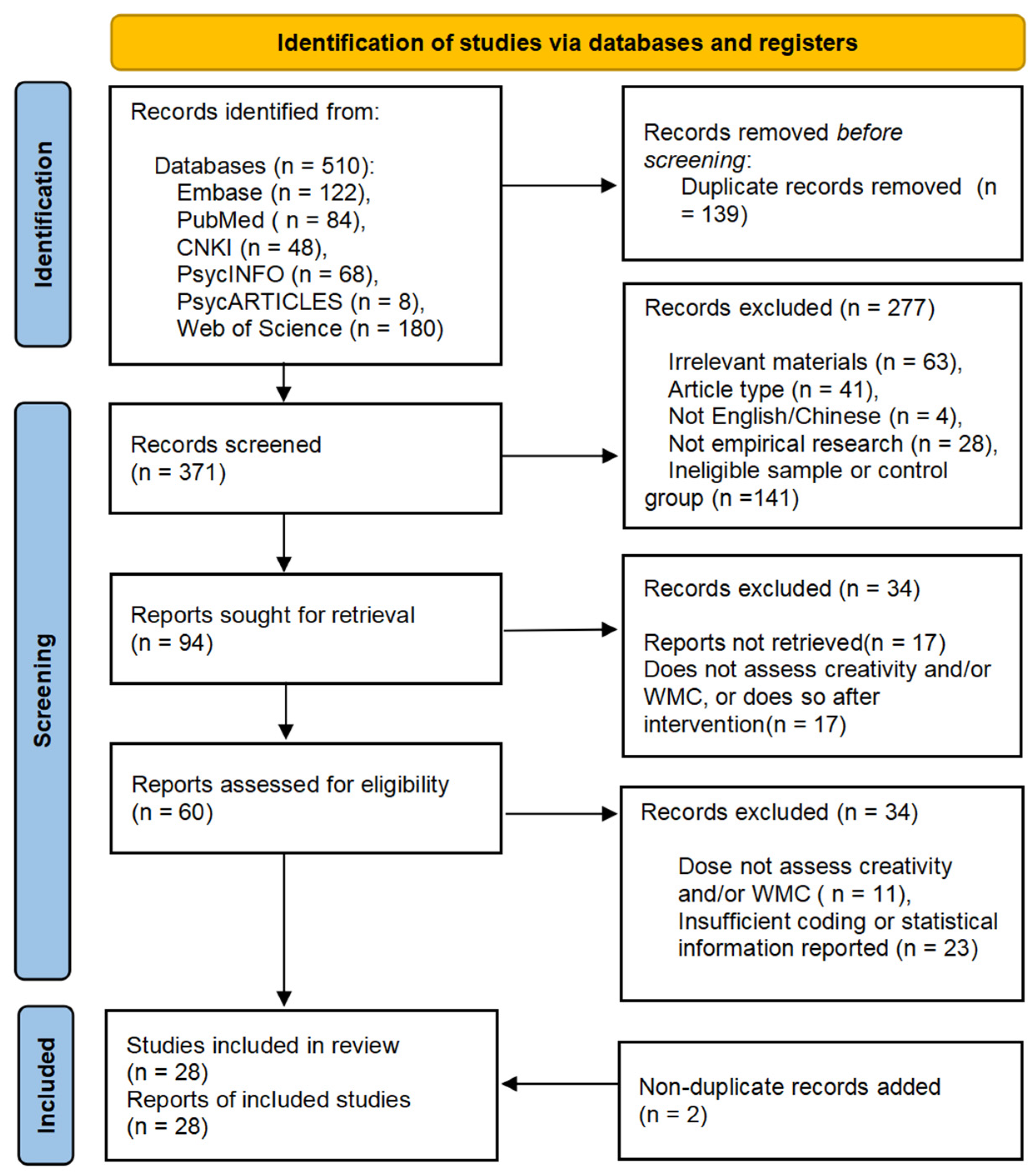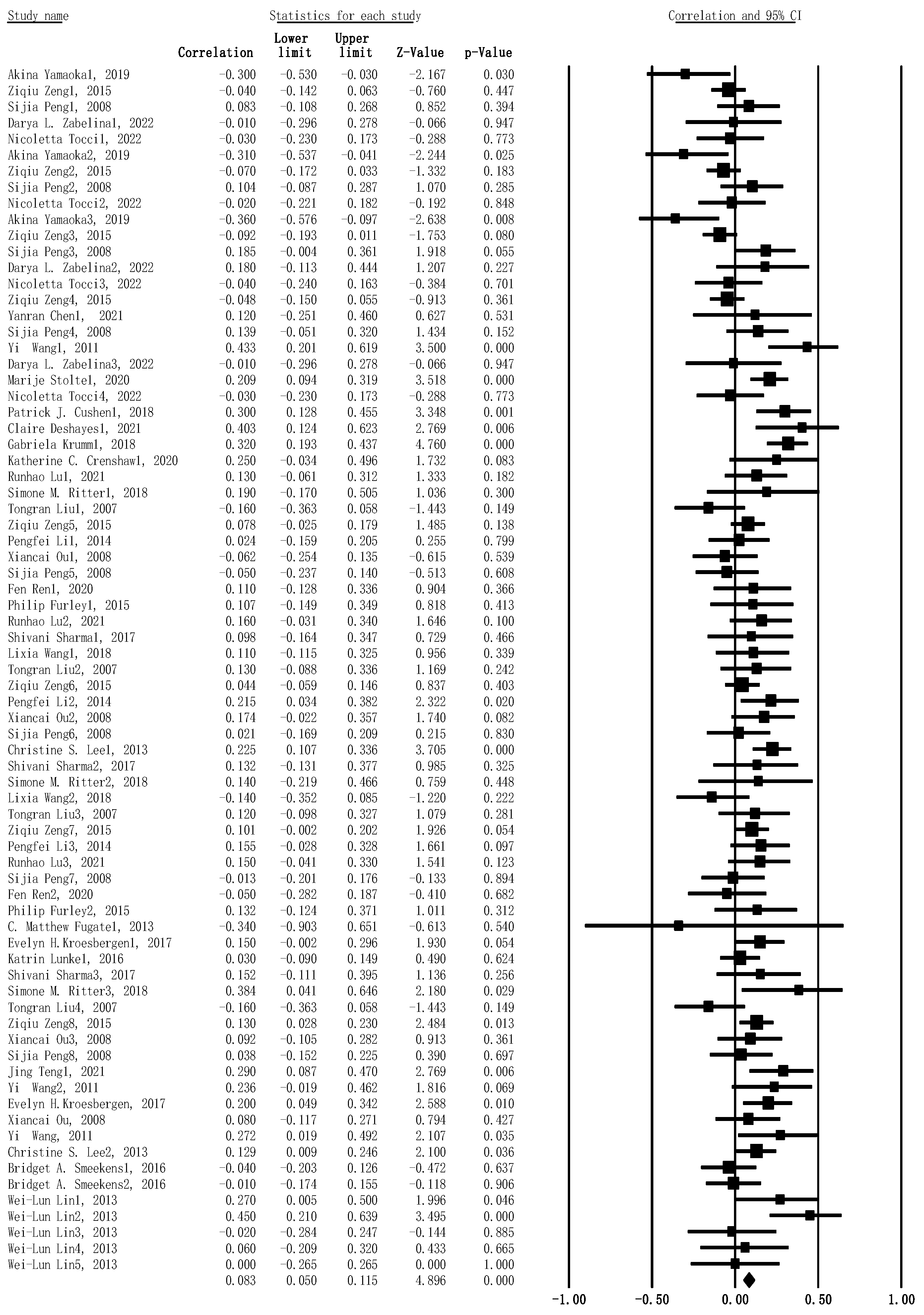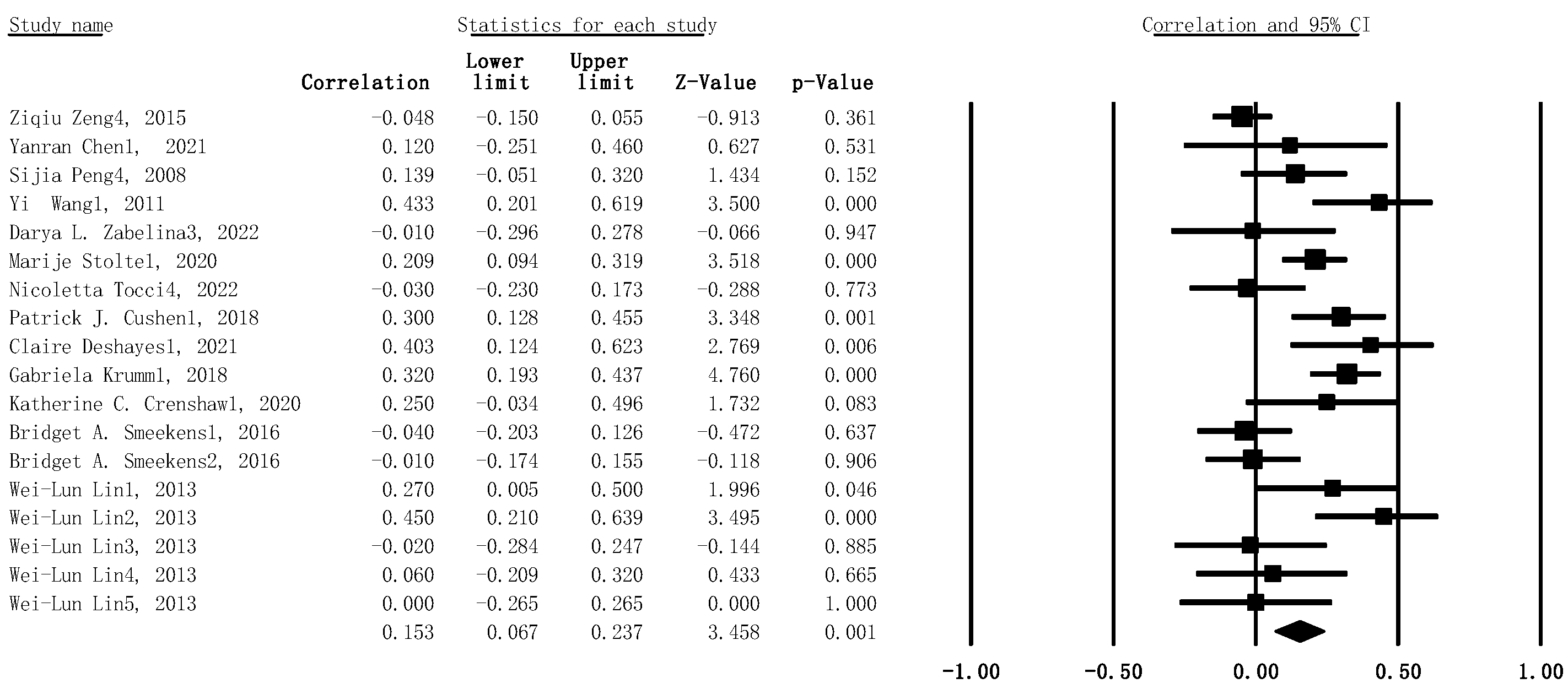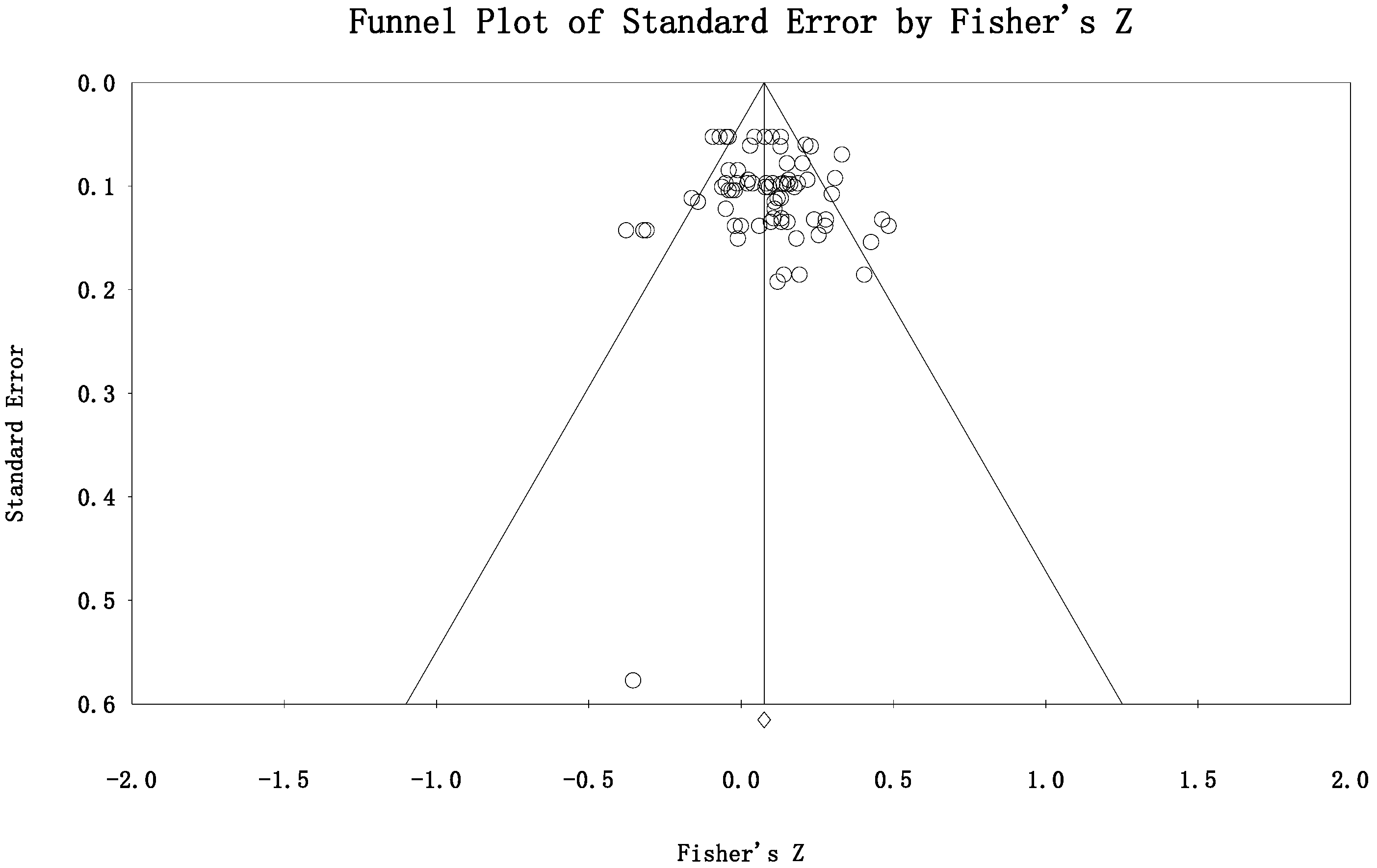A Positive Association between Working Memory Capacity and Human Creativity: A Meta-Analytic Evidence
Abstract
1. Introduction
2. Materials and Methods
2.1. Search Strategy
2.2. Study Selection
2.3. Encoding and Statistical Analysis
2.4. Quality Analysis
2.5. Statistical Analysis
3. Results
3.1. Main Meta-Analysis
3.2. Subgroup Meta-Analysis
3.2.1. Verbal WMC Tasks and Creativity
3.2.2. Visual–Spatial WMC Tasks and Creativity
3.2.3. Dual-Tasks and Creativity
3.3. Moderation-Effect Analysis
3.3.1. Moderation-Effect of Culture
3.3.2. Moderation-Effect of Age
3.3.3. Moderation-Effect of WMC Type
3.4. Publication Bias and Quality Assessment
4. Discussion
5. Limitation
6. Conclusions
Supplementary Materials
Author Contributions
Funding
Institutional Review Board Statement
Informed Consent Statement
Data Availability Statement
Acknowledgments
Conflicts of Interest
References
- Alderson, R. Matt, Lisa J. Kasper, Kristen L. Hudec, and Connor H. Patros. 2013. Attention-deficit/hyperactivity disorder (ADHD) and working memory in adults: A meta-analytic review. Neuropsychology 27: 287–302. [Google Scholar] [CrossRef] [PubMed]
- Baas, Matthijs, Carsten K. De Dreu, and Bernard A. Nijstad. 2008. A meta-analysis of 25 years of mood-creativity research: Hedonic tone, activation, or regulatory focus? Psychological Bulletin 134: 779–806. [Google Scholar] [CrossRef] [PubMed]
- Baddeley, Alan. 2003. Working memory: Looking back and looking forward. Nature Reviews Neuroscience 4: 829–39. [Google Scholar] [CrossRef]
- Baddeley, Alan. 2012. Working memory: Theories, models, and controversies. Annual Review of Psychology 63: 1–29. [Google Scholar] [PubMed]
- Beaty, Roger E., and Paul J. Silvia. 2012. Why do ideas get more creative across time? An executive interpretation of the serial order effect in divergent thinking tasks. Psychol Aesthet Creat Arts 6: 309–19. [Google Scholar] [CrossRef]
- Borenstein, Michael. 2022. Comprehensive Meta-Analysis Software Systematic Reviews in Health Research. London: BMJ Books, pp. 535–48. [Google Scholar]
- Borenstein, Michael, Larry V. Hedges, Julian P. Higgins, and Hannah R. Rothstein. 2011. Introduction to Meta-Analysis. Hoboken: Wiley & Sons. [Google Scholar]
- Brockwell, Sarah, and Ian Gordon. 2001. A comparison of statistical methods for meta-analysis. Statistics in Medicine 20: 825–40. [Google Scholar] [CrossRef]
- Chein, Jason M., and Robert W. Weisberg. 2014. Working memory and insight in verbal problems: Analysis of compound remote associates. Memory and Cognition 42: 67–83. [Google Scholar] [CrossRef]
- Chen, Qunlin, Roger E. Beaty, Dongtao Wei, Junyi Yang, Jiangzhou Sun, Wei Liu, Wenjing Yang, Qinglin Zhang, and Jiang Qiu. 2018. Longitudinal Alterations of Frontoparietal and Frontotemporal Networks Predict Future Creative Cognitive Ability. Cerebral Cortex 28: 103–15. [Google Scholar] [CrossRef]
- Chen, Yanran. 2021. The Activation Process of Semantic Information and the Regulatory Role of Executive Function in Creative Thinking. Wuhan: Central China Normal University. [Google Scholar]
- Cowan, Nelson. 2014. Working Memory Underpins Cognitive Development, Learning, and Education. Educational Psychology Review 26: 197–223. [Google Scholar] [CrossRef]
- Crenshaw, Katherine, and Stephanie Miller. 2022. Creativity and Executive Function in School-Age Children: Effects of Creative Coloring and Individual Creativity on an Executive Function Sorting Task. Psi Chi Journal of Psychological Research 27: 81–90. [Google Scholar] [CrossRef]
- Cushen, Patrick J., and Jennifer Wiley. 2018. Both attentional control and the ability to make remote associations aid spontaneous analogical transfer. Memory and Cognition 46: 1398–412. [Google Scholar] [CrossRef] [PubMed]
- De Dreu, Carsten K. W., Bernard A. Nijstad, and Matthijs Baas. 2011. Behavioral Activation Links to Creativity Because of Increased Cognitive Flexibility. Social Psychological and Personality Science 2: 72–80. [Google Scholar] [CrossRef]
- De Dreu, Carsten K., Bernard A. Nijstad, Matthijs Baas, Inge Wolsink, and Marieke Roskes. 2012. Working memory benefits creative insight, musical improvisation, and original ideation through maintained task-focused attention. Personality and Social Psychology Bulletin 38: 656–69. [Google Scholar] [CrossRef] [PubMed]
- Degmečić, Dunja. 2018. Schizophrenia and creativity. Psychiatria Danubina 30: 224–27. [Google Scholar]
- DeHaan, Robert L. 2009. Teaching creativity and inventive problem solving in science. CBE Life Sciences Education 8: 172–81. [Google Scholar] [CrossRef]
- Deshayes, Claire, Véronique Paban, Marie-Hélène Ferrer, Béatrice Alescio-Lautier, and Caroline Chambon. 2021. A comprehensive approach to study the resting-state brain network related to creative potential. Brain Structure and Function 226: 1743–53. [Google Scholar] [CrossRef]
- Diamond, Adele. 2013. Executive functions. Annual Review of Psychology 64: 135–68. [Google Scholar] [CrossRef]
- Dygert, Sarah K. C., and Andrew F. Jarosz. 2020. Individual differences in creative cognition. Journal of Experimental Psychology General 149: 1249–74. [Google Scholar] [CrossRef]
- Egger, Matthias, and George Davey Smith. 1997. Meta-Analysis. Potentials and promise. BMJ 315: 1371–74. [Google Scholar] [CrossRef]
- Fancourt, Daisy, and Andrew Steptoe. 2019. Effects of creativity on social and behavioral adjustment in 7- to 11-year-old children. Annals of the New York Academy of Sciences 1438: 30–39. [Google Scholar] [CrossRef]
- Fugate, C. Matthew, Sydney Zentall, and Marcia Gentry. 2013. Creativity and Working Memory in Gifted Students with and Without Characteristics of Attention Deficit Hyperactive Disorder Lifting the Mask. Gifted Child Quarterly 57: 234–46. [Google Scholar] [CrossRef]
- Furley, Philip, and Daniel Memmert. 2015. Creativity and working memory capacity in sports: Working memory capacity is not a limiting factor in creative decision making amongst skilled performers. Frontiers in Psychology 6: 115. [Google Scholar] [CrossRef] [PubMed]
- Gajda, Aleksandra, Maciej Karwowski, and Ronald Beghetto. 2017. Creativity and Academic Achievement: A Meta-Analysis. Journal of Educational Psychology 109: 269–99. [Google Scholar] [CrossRef]
- Gilhooly, Ken, and Evridiki Fioratou. 2009. Executive functions in insight versus non-insight problem solving: An individual differences approach. Thinking & Reasoning 15: 355–76. [Google Scholar]
- Gold, James M., Benjamin Robinson, Carly J. Leonard, Britta Hahn, Shuo Chen, Robert P. McMahon, and Steven J. Luck. 2018. Selective Attention, Working Memory, and Executive Function as Potential Independent Sources of Cognitive Dysfunction in Schizophrenia. Schizophrenia Bulletin 44: 1227–34. [Google Scholar] [CrossRef] [PubMed]
- Goncalo, Jack, and Barry Staw. 2006. Individualism-Collectivism and Group Creativity. Organizational Behavior and Human Decision Processes 100: 96–109. [Google Scholar] [CrossRef]
- Guilford, Joy Paul. 1950. Creativity. American Psychologist 5: 444–54. [Google Scholar] [CrossRef]
- Guilford, Joy Paul. 1968. The nature of human intelligence. American Educational Research Journal 5: 249. [Google Scholar]
- Hempel, Pal S., and Christina Sue-Chan. 2010. Culture and the Assessment of Creativity. Management and Organization Review 6: 415–35. [Google Scholar] [CrossRef]
- Hennessey, Beth A., and Teresa M. Amabile. 2010. Creativity. Annual Review of Psychology 61: 569–98. [Google Scholar] [CrossRef]
- Korovkin, Segei, Ilya Vladimirov, Alexandra Chistopolskaya, and Anna Savinova. 2018. How Working Memory Provides Representational Change During Insight Problem Solving. Frontiers in Psychology 9: 1864. [Google Scholar] [CrossRef]
- Kroesbergen, Evelyn, and Eveline Schoevers. 2017. Creativity as Predictor of Mathematical Abilities in Fourth Graders in Addition to Number Sense and Working Memory. Journal of Numerical Cognition 3: 417–40. [Google Scholar] [CrossRef]
- Krumm, Gabriela, Vanessa Arán Filippetti, and Marisel Gutierrez. 2018. The contribution of executive functions to creativity in children: What is the role of crystallized and fluid intelligence? Thinking Skills and Creativity 29: 185–95. [Google Scholar] [CrossRef]
- Lee, Andy C., and Sarah R. Rudebeck. 2010. Investigating the interaction between spatial perception and working memory in the human medial temporal lobe. Journal of Cognitive Neuroscience 22: 2823–35. [Google Scholar] [CrossRef]
- Lee, Christine S., and David J. Therriault. 2013. The cognitive underpinnings of creative thought: A latent variable analysis exploring the roles of intelligence and working memory in three creative thinking processes. Intelligence 41: 306–20. [Google Scholar] [CrossRef]
- Leung, Kwok, and Jie Wang. 2015. A Cross-Cultural Analysis of Creativity. New York: Oxford University Press, pp. 261–78. [Google Scholar]
- Li, P. 2008. The Relationship between Mind Wandering as a Personal Characteristic and Creativity. Jinhua: Zhejiang Normal University. [Google Scholar]
- Lin, Wei-Lun, and Yunn-Wen Lien. 2013. The Different Role of Working Memory in Open-Ended Versus Closed-Ended Creative Problem Solving: A Dual-Process Theory Account. Creativity Research Journal 25: 85–96. [Google Scholar] [CrossRef]
- Liu, Tongran, and Jiannong Shi. 2007. Relationship Among Working Memory, Intelligence and Creativity of the 9–11 Years Old Children. Chinese Journal of Clinical Psychology 15: 164–67. [Google Scholar]
- Lo, Carson Ka, Dominik Mertz, and Mark Loeb. 2014. Newcastle-Ottawa Scale: Comparing reviewers’ to authors’ assessments. BMC Medical Research Methodology 14: 45. [Google Scholar] [CrossRef]
- Lu, Runhao, Yanna Zhang, Naili Bao, Meng Su, Xingli Zhang, and Jiannong Shi. 2021. Visuospatial, rather than verbal working memory capacity plays a key role in verbal and figural creativity. Thinking and Reasoning 28: 29–60. [Google Scholar] [CrossRef]
- Lunke, Katrin, and Beat Meier. 2016. Disentangling the Impact of Artistic Creativity on Creative Thinking, Working Memory, Attention, and Intelligence: Evidence for Domain-Specific Relationships with a New Self-Report Questionnaire. Frontiers in Psychology 7: 1089. [Google Scholar] [CrossRef]
- Makinde, Funmilayo L., Milaine S. S. Tchamga, James Jafali, Segun Fatumo, Emile R. Chimusa, Nicola Mulder, and Gaston K. Mazandu. 2021. Reviewing and assessing existing meta-analysis models and tools. Briefings in Bioinformatics 22: bbab324. [Google Scholar] [CrossRef]
- Miller, Earl K., Mikael Lundqvist, and André M. Bastos. 2018. Working Memory 2.0. Neuron 100: 463–75. [Google Scholar] [CrossRef]
- Murray, M., and Ruth Byrne. 2013. Cognitive change in insight problem solving: Initial model errors and counterexamples. Journal of Cognitive Psychology 25: 210–19. [Google Scholar] [CrossRef]
- Niu, Weihua, and Robert Sternberg. 2002. Contemporary Studies on the Concept of Creativity: The East and the West. The Journal of Creative Behavior 36: 266–88. [Google Scholar] [CrossRef]
- Niu, Weihua, and Robert Sternberg. 2003. Societal and School Influences on Student Creativity: The Case of China. Psychology in the Schools 40: 103–14. [Google Scholar] [CrossRef]
- Orth, Dominic, Luke McDonic, Chris Ashbrook, and John van der Kamp. 2019. Efficient search under constraints and not working memory resources supports creative action emergence in a convergent motor task. Human Movement Science 67: 102505. [Google Scholar] [CrossRef]
- Ou, Xiancai. 2008. A Study on the Correlation between Working Memory Span and Creative Thinking. Kirkland: Northwest University. [Google Scholar]
- Ovando-Tellez, Marcela, Yoed N. Kenett, Mathias Benedek, Matthieu Bernard, Joan Belo, Benoit Beranger, Theophile Bieth, and Emmanuelle Volle. 2022. Brain connectivity-based prediction of real-life creativity is mediated by semantic memory structure. Science Advances 8: eabl4294. [Google Scholar] [CrossRef]
- Page, Matthew J., Joanne E. McKenzie, Patrick M. Bossuyt, Isabelle Boutron, Tammy C. Hoffmann, Cynthia D. Mulrow, Larissa Shamseer, Jennifer M. Tetzlaff, Elie A. Akl, Sue E. Brennan, and et al. 2021. The PRISMA 2020 statement: An updated guideline for reporting systematic reviews. BMJ 372: n71. [Google Scholar] [CrossRef] [PubMed]
- Peng, Peng, Marcia Barnes, CuiCui Wang, Wei Wang, Shan Li, H. Lee Swanson, William Dardick, and Sha Tao. 2018. A meta-analysis on the relation between reading and working memory. Psychological Bulletin 144: 48–76. [Google Scholar] [CrossRef]
- Peng, Sijia. 2008. An Experimental Study on the Relationship between Creative Thinking, Processing Speed and Working Memory. Xi’an: Shaanxi Normal University. [Google Scholar]
- Reid, Jackson B., F. J. King, and Pat N. Wickwire. 1959. Cognitive and other Personality Characteristics of Creative Children. Psychological Reports 5: 729–37. [Google Scholar] [CrossRef]
- Ren, Fen, Yang Liu, Yanxue Wang, and Gongxiang Chen. 2020. Relationship between Continued—Influence Effect of Misinformation and Working Memory Capacity: A Mediating Role of Creativity. Psychology: Techniques and Applications 8: 604–10. [Google Scholar]
- Ritter, Simone M., Jens Abbing, and Hein T. van Schie. 2018. Eye-Closure Enhances Creative Performance on Divergent and Convergent Creativity Tasks. Frontiers in Psychology 9: 1315. [Google Scholar] [CrossRef] [PubMed]
- Rudowicz, Elisabeth. 2003. Creativity and Culture: A two way interaction. Scandinavian Journal of Educational Research 47: 273–90. [Google Scholar] [CrossRef]
- Sharma, Shivani, and Nandita Babu. 2017. Interplay between Creativity, Executive Function and Working Memory in Middle-Aged and Older Adults. Creativity Research Journal 29: 71–77. [Google Scholar] [CrossRef]
- Smeekens, Bridget A., and Michael J. Kane. 2016. Working Memory Capacity, Mind Wandering, and Creative Cognition: An Individual-Differences Investigation into the Benefits of Controlled Versus Spontaneous Thought. Psychology of Aesthetics, Creativity, and the Arts 10: 389–415. [Google Scholar] [CrossRef] [PubMed]
- Sternberg, Robert J., and Todd I. Lubart. 1999. The Concept of Creativity: Prospects and Paradigms. New York: Cambridge University Press. [Google Scholar]
- Sterne, Jonathan A. C., and Matthias Egger. 2005. Regression Methods to Detect Publication and Other Bias in Meta-Analysis Publication Bias in Meta—Analysis. In Publication Bias in Meta-Analysis: Prevention, Assessment and Adjustments. New York: Wiley, pp. 99–110. [Google Scholar]
- Stolte, Marije, Trinidad García, Van Johannes E. H. Luit, Bob Oranje, and Evelyn H. Kroesbergen. 2020. The Contribution of Executive Functions in Predicting Mathematical Creativity in Typical Elementary School Classes: A Twofold Role for Updating. Journal of Intelligence 8: 26. [Google Scholar] [CrossRef] [PubMed]
- Sun, Jiangzhou, Qunlin Chen, Qinglin Zhang, Yadan Li, Haijiang Li, Dongtao Wei, Wenjing Yang, and Jiang Qiu. 2016. Training your brain to be more creative: Brain functional and structural changes induced by divergent thinking training. Human Brain Mapping 37: 3375–87. [Google Scholar] [CrossRef] [PubMed]
- Takeuchi, Hikaru, Yasuyuki Taki, Rui Nouchi, Ryoichi Yokoyama, Yuka Kotozaki, Seishu Nakagawa, Atsushi Sekiguchi, Kunio Iizuka, Sugiko Hanawa, Tsuyoshi Araki, and et al. 2020. Originality of divergent thinking is associated with working memory–related brain activity: Evidence from a large sample study. Neuroimage 216: 116825. [Google Scholar] [CrossRef]
- Teng, Jing. 2021. Research on the Cognitive and Neural Basis of Visual Art Creativity from the Perspective of Expertise. Shanghai: East China Normal University. [Google Scholar]
- Teng, Jing, Wangbing Shen, and Ning Hao. 2018. The role of cognitive control in divergent thinking. Advances in Psychological Science 26: 411–22. [Google Scholar]
- Tocci, Nicoletta, Patrizia Scibinetti, Emiliano Mazzoli, Myrto Foteini Mavilidi, Ilaria Masci, Mirko Schmidt, and Caterina Pesce. 2022. Giving Ideas Some Legs or Legs Some Ideas? Children’s Motor Creativity Is Enhanced by Physical Activity Enrichment: Direct and Mediated Paths. Frontiers in Psychology 13: 806065. [Google Scholar] [CrossRef]
- Vally, Zahir, Leen Salloum, Dina AlQedra, Sara El Shazly, Maryam Albloshi, Safeya Alsheraifi, and Alia Alkaabi. 2019. Examining the effects of creativity training on creative production, creative self-efficacy, and neuro-executive functioning. Thinking Skills and Creativity 31: 70–78. [Google Scholar] [CrossRef]
- Wagner, Barry T., Lauren A. Shaffer, Olivia A. Ivanson, and James A. Jones. 2021. Assessing working memory capacity through picture span and feature binding with visual-graphic symbols during a visual search task with typical children and adults. Augmentative and Alternative Communication 37: 39–51. [Google Scholar] [CrossRef] [PubMed]
- Wang, Yi. 2011. The Influence of Working Memory Span and Central Executive Function on Undergraduates’ Creativity. Kaifeng: Henan University. [Google Scholar]
- Wang, Lixia, Haiying Long, Jonathan A. Plucker, Qing Wang, Xiaobo Xu, and Weiguo Pang. 2018. High Schizotypal Individuals Are More Creative? The Mediation Roles of Overinclusive Thinking and Cognitive Inhibition. Frontiers in Psychology 9: 1766. [Google Scholar] [CrossRef] [PubMed]
- Wang, Shuoyang, Chongde Lin, and Hanyin Sun. 2020. The Mechanism of Associative Abilities in Creative Problem Solving. Studies of Psychology and Behavior 18: 8–16. [Google Scholar]
- Wiley, Jennifer, and Andrew F. Jarosz. 2012. Chapter Six—How Working Memory Capacity Affects Problem Solving. In Psychology of Learning and Motivation. Edited by Brian H. Ross. Cambridge: Academic Press, vol. 56, pp. 185–227. [Google Scholar]
- Xu, Zhan, Qiangqiang Li, and Jiang Qiu. 2017. The Prediction of Working Memory Capacity to Creative Thinking. Journal of Psychological Science 40: 64–69. [Google Scholar]
- Yamaoka, Akina, and Shinataro Yukawa. 2020. Does Mind Wandering During the Thought Incubation Period Improve Creativity and Worsen Mood? Psychological Reports 123: 1785–800. [Google Scholar] [CrossRef]
- Zabelina, Darya L., Naomi P. Friedman, and Jessica Andrews-Hanna. 2019. Unity and diversity of executive functions in creativity. Consciousness and Cognition 68: 47–56. [Google Scholar] [CrossRef]
- Zeng, Ziqiu. 2015. The Relationship between Executive Function and Creativity in 9-year-old Children. Beijing: Beijing Forestry University. [Google Scholar]
- Zhang, Xinru, Wei Wang, Haijun Duan, Yangyang Zhao, Yuecui Kan, and Weiping Hu. 2019. Effect of Working Memory on Insight and Analytic Problem Solving. Journal of Psychological Science 42: 777–83. [Google Scholar]
- Zhuang, Kaixiang, Wenjing Yang, Yu Li, Jie Zhang, Qunlin Chen, Jie Meng, Dongtao Wei, Jiangzhou Sun, Li He, Yu Mao, and et al. 2021. Connectome-based evidence for creative thinking as an emergent property of ordinary cognitive operations. Neuroimage 227: 117632. [Google Scholar] [CrossRef]






| Author | Publication Time | Region | Sample Size | Age | Gender | Subject Category | Working Memory Measures | Creativity Measures | Variable Relation | |
|---|---|---|---|---|---|---|---|---|---|---|
| Male | Female | |||||||||
| (Yamaoka and Yukawa 2020) | 2019 | Japan | 52 | 18.96 ± 1.21 | 19 | 33 | College students | OSPAN and SSPAN | UUT | Dual-tasks and creativity |
| (Zeng 2015) | 2015 | CN | 364 | 9.4 ± 0.45 | 182 | 182 | Schoolchildren | Digit Span Backwards/N-Back | CAT, TTCT | Verbal WMC tasks/Dual-tasks and creativity |
| (Peng 2008) | 2008 | CN | 108 | 17.66 ± 0.74 | 62 | 46 | Students | Digital comparison task/space tracking task | Creative Thinking Test | Verbal WMC tasks/Visual–spatial and creativity |
| (Zabelina et al. 2019) | 1 February 2022 | USA | 47 | 29.26 ± 7.93 | 23 | 24 | Neuro-typical adult | WMC updating tasks | ATTA, CAQ | Dual-tasks and creativity |
| (Tocci et al. 2022) | 10 March 2022 | Italy | 95 | 7.8 ± 1.3 | 47 | 48 | Schoolchildren | Random Number Generation Task. | TTCT | Dual-tasks and creativity |
| (Chen 2021) | 2021 | CN | 30 | NA | NA | NA | Students | Short-term memory task | AUT | Dual-tasks and creativity |
| (Wang 2011) | 2011 | CN | 60 | 18–24 | NA | NA | College students | Operation word breadth task/point matrix task | WCAP | Verbal WMC tasks/Visual–spatial WMC tasks/Dual-tasks and creativity |
| (Stolte et al. 2020) | 2 June 2020 | The Netherlands | 278 | 9.71 ± 0.93 | 139 | 139 | Schoolchildren | the Monkey Game/the lion game | the Mathematical Creativity task | Dual-tasks and creativity |
| (Cushen and Wiley 2018) | 2 August2018 | USA | 120 | 19.39 ± 1.74 | NA | NA | College students | OSPAN and SSPAN | RAT | Dual-tasks and creativity |
| (Deshayes et al. 2021) | 7 May 2021 | Germany | 45 | 14.13 ± 3.25 | 22 | 23 | Normal person | WMC updating tasks | TTCT | Dual-tasks and creativity |
| (Krumm et al. 2018) | 30 July 2018 | Argentina | 209 | NA | NA | NA | Schoolchildren | WISC-IV | TTCT | Dual-tasks and creativity |
| (Crenshaw and Miller 2022) | 9 May 2020 | USA | 49 | 9±0.25 | 19 | 30 | Schoolchildren | WAIS –III | AUT | Dual-tasks and creativity |
| (Lu et al. 2021) | 14 April 2021 | CN | 107, 68, 64 | 20.45 ± 3.31, 21.49 ± 2.26, 23.23 ± 3.83 | 45, 31, 27 | 62, 37, 37 | College students | Verbal tasks and Visual–spatial task/The tapping task | TTCT | Verbal WMC tasks/Visual–spatial WMC tasks and Verbal\Figure creativity |
| (Ritter et al. 2018) | 31 July 2018 | The Netherlands | 32 | 19.7 | NA | NA | College students | DS | RAT | Verbal WMC tasks and creativity |
| (Liu and Shi 2007) | 2007 | CN | 83 | 9/10/11 ± 0.25 | 50 | 33 | Schoolchildren | Sternberg WM Paradigm | WCAP, CAT | Verbal WMC tasks and creativity |
| (Li 2008) | 2014 | CN | 116 | 18–24 | 31 | 85 | College students | OSPAN | UUT | Verbal WMC tasks and creativity |
| (Xiancai Ou 2008) | 2008 | CN | 101 | 19.62 | 65 | 44 | College students | Operation—word width task/point matrix space width task | Creative Thinking Scale | Verbal WMC tasks/Visual–spatial WMC tasks and creativity |
| (Ren et al. 2020) | 2020 | CN | 70 | 19.84 ± 1.46 | 27 | 43 | College students | Verbal WM tasks | WPMF | Verbal WMC tasks and creativity |
| (Furley and Memmert 2015) | 10 February 2015 | Germany | 61 | 23.48 ± 3.6 | 61 | 0 | Soccer athletes | OSPAN | DT test | Verbal WMC tasks and creativity |
| (Sharma and Babu 2017) | 2 February 2017 | India | 58 | 52.05, 57.21, 62.05 | 25 | 33 | Middle-aged and older adults | PGI memory scale | TTCT | Verbal WMC tasks and creativity |
| (Wang et al. 2018) | 21 September 2018 | CN | 78 | 21.54 ± 1.33, 21.73 ± 1.45 | 9 | 69 | Neuro-typical adult | OSPAN, RAPM, number-letter task | AUT | Verbal WMC tasks/Dual-tasks and creativity |
| (Lee and Therriault 2013) | 5 June 2013 | USA | 265 | 20.33 ± 2.54 | 59 | 206 | College students | Symmetry Span task/Backward Digit Span task | AF tasks, DT tests, CT tests | Verbal WMC tasks/Visual–spatial tasks and creativity |
| (Fugate et al. 2013) | 30 August 2013 | USA | 6 | NA | NA | NA | Gifted Students Without ADHD characteristics | The Woodcock Johnson III | TTCT | Verbal WMC tasks and creativity |
| (Kroesbergen and Schoevers 2017) | 22 December 2017 | The Netherlands | 166 | 9.66 ± 0.58 | 79 | 87 | Schoolchildren | Two computerized WM tasks | TCT-DP, MCT | Verbal WMC tasks/Visual–spatial and creativity/mathematical creativity |
| (Lunke and Meier 2016) | 28 July 2016 | Switzerland | 270 | 26.19 ± 8.52 | NA | NA | Neuro-typical adult | RST | ACDC | Verbal WMC tasks and artistic Creativity |
| (Teng 2021) | 2021 | CN | 89 | 21.96 | 19 | 70 | College students | OSPAN | AUT, TTCT, Creative tasks | Verbal WMC tasks and Artistic Creativity |
| (Smeekens and Kane 2016) | 7 May 2013 | CN | 55 | 20.3 ± 1.2 | 21 | 34 | College students | N-back tasks | DT tasks | Dual-tasks and creativity |
| (Lin and Lien 2013) | 15 February 2016 | USA | 173, 142 | NA | NA | NA | College students | OSPAN and SSPAN | AUT, SART | Dual-tasks and creativity |
Disclaimer/Publisher’s Note: The statements, opinions and data contained in all publications are solely those of the individual author(s) and contributor(s) and not of MDPI and/or the editor(s). MDPI and/or the editor(s) disclaim responsibility for any injury to people or property resulting from any ideas, methods, instructions or products referred to in the content. |
© 2023 by the authors. Licensee MDPI, Basel, Switzerland. This article is an open access article distributed under the terms and conditions of the Creative Commons Attribution (CC BY) license (https://creativecommons.org/licenses/by/4.0/).
Share and Cite
Gong, Z.; Miao, K.; Liu, X.; Luo, M.; Yu, Y.; Chen, Z. A Positive Association between Working Memory Capacity and Human Creativity: A Meta-Analytic Evidence. J. Intell. 2023, 11, 15. https://doi.org/10.3390/jintelligence11010015
Gong Z, Miao K, Liu X, Luo M, Yu Y, Chen Z. A Positive Association between Working Memory Capacity and Human Creativity: A Meta-Analytic Evidence. Journal of Intelligence. 2023; 11(1):15. https://doi.org/10.3390/jintelligence11010015
Chicago/Turabian StyleGong, Zheng, Kuan Miao, Xuerong Liu, Mengjie Luo, Yang Yu, and Zhiyi Chen. 2023. "A Positive Association between Working Memory Capacity and Human Creativity: A Meta-Analytic Evidence" Journal of Intelligence 11, no. 1: 15. https://doi.org/10.3390/jintelligence11010015
APA StyleGong, Z., Miao, K., Liu, X., Luo, M., Yu, Y., & Chen, Z. (2023). A Positive Association between Working Memory Capacity and Human Creativity: A Meta-Analytic Evidence. Journal of Intelligence, 11(1), 15. https://doi.org/10.3390/jintelligence11010015





